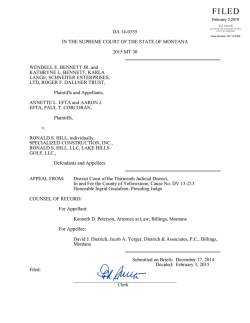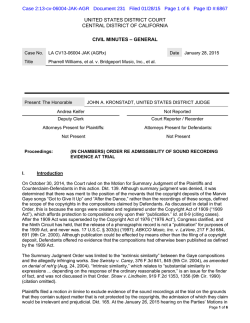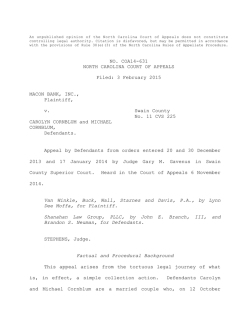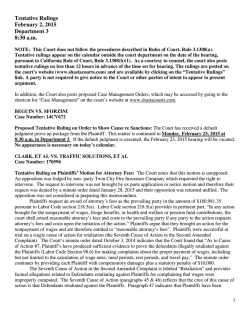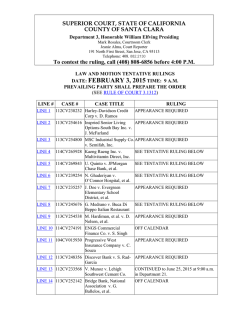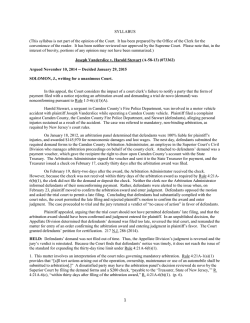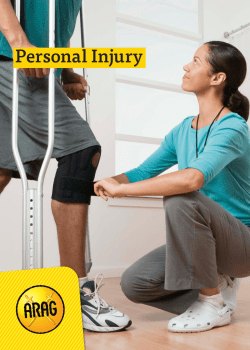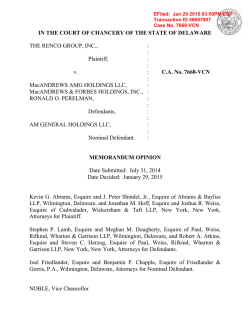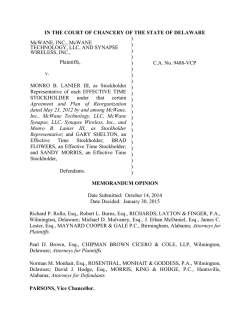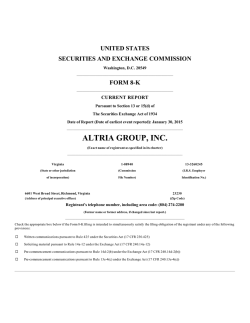
Smith v. DeZao - Legal Malpractice Lawyer Blog
SMITH v. DEZAO, ESQUIRE et al
Doc. 39
NOT FOR PUBLICATION
THE UNITED STATES DISTRICT COURT
DISTRICT OF NEW JERSEY
SHAWN SMITH,
Civil Action No. 2:13-cv-72 (JLL) (JAD)
OPINION AND ORDER
Plaintiff,
v.
JAMES C. DEZAO, et al,
Defendants.
JOSEPH A. DICKSON, U.S.M.J.
This matter comes before the Court by way of Defendants' request to re-open and/or rep at
the discovery taken in the underlying action, Smith et al. v. Resort Condominiums Intematio
Inc., et al., Case No. 2:07-cv-00437, 1 on the issue of Andrew Smith's alleged alcohol consumpt n
on the night of his tragic death. (See ECF Nos. 27-30, and 35). Upon careful consideration of e
parties' submissions, and for the reasons stated below, Defendants' request is GRANTED.
I.
BACKGROUND
This action involves Defendants' alleged legal malpractice in the underlying case, S
et al. v. Resort Condominiums Internationals, Inc., et al., Case No. 2:07-cv-00437. (Compla t,
ECF No. 1, if if 1, 38-39). Defendants, James C. Dezao, Esquire, Law Offices of James C. Dez o,
P.A. f/k/a Dezao & Dibrigida, LLC, and John/Jane Doe(s), (hereinafter collectively referred t
"Defendants"), represented Nancy Smith and Harold Smith, husband and wife, the plaintiffs in
e
1
Unless otherwise noted, the citations in this Order refer to the present matter, Case No. 2: 13- 72.
1
Dockets.Justia.com
underlying action. (Id. at 6, ii 32). In that case, Nancy and Harold Smith brought a neglige
e
action against multiple defendants as a result of their son, Andrew Smith's, tragic death duri g
their family vacation in Cancun, Mexico. (Id.). Defendants allegedly failed to timely fi1 a
Complaint on behalf of the Plaintiff in the present case, Shawn Smith, Nancy and Harold Smit 's
other son, for negligent infliction of emotional distress after having "observed through sight
sound the serious physical injury and eventual death of his younger brother, Andrew."
ffih at
ii 41-43).
The Smith family booked a weeklong vacation set to begin on June 17, 2006 to Cane
Mexico.
ffih
at 4,
ii 12).
,
In October of 2005 a hurricane caused massive destruction tom
resorts, including Hotel Y Villas Solaris (hereinafter "Solaris"), the resort the Smith family wa o
stay in a few months later. (Id. at 4,
ii ii 11-12). Although the Smith family was advised t at
Solaris was "fully functional and all repairs from a recent hurricane were completed," they arri
only to discovery much of the hotel under construction and "the elevator(s) were not working;
the hotel's [sic] two elevators was subsequently placed into service, while the other elev
continued to be out-or service, [sic] with the open elevator shaft barricaded by three large pie s
of plywood." (Id. at 4, ii ii 13, 15).
On June 21, 2006, Andrew Smith "pushed the elevator call button to summons [sic]
working elevator on the fourth floor and then stood adjacent to a plywood barrier covering
elevator shaft of the adjacent non-functioning broken elevator."
ffih at 5, ii 20).
e
Andrew le
against the plywood barrier, which gave way, and fell down the elevator shaft. (Id. at 5, ii 21).
subsequently died from the injuries he sustained in the fall. (Id. at 6,
ii 31 ).
Prior to Andre
death, Plaintiff observed his brother in the elevator shaft and audibly heard his brother cry out
help. (Id. at 5, ii ii 22-23). Plaintiff had continuous contact with his brother until an ambul
2
r
arrived, transporting Andrew to the nearest hospital where he was rushed into surgery. (Id. at 6, if if 24-30). Unfortunately, he died in surgery that same day. (Id. at 6, if 31 ).
On July 5, 2006, Nancy Smith executed a contingency fee agreement with Defendants o
represent the Smith family and the Estate of Andrew Robert Smith, as a result of the June 21, 20 6
incident. (Id. at 6,
if 32). Plaintiff alleges that during their initial meetings, Nancy and Har
Smith informed Defendants that they "observed the serious physical injury and eventual death
their son Andrew ... and suffered severe emotion distress as a result."
llih at 6, if 33).
Plain
also alleges that during their initial meetings, Nancy and Harold Smith further inform d
Defendants that Plaintiff "observed through sight and sound the serious physical injury a d
eventual death of his younger brother, Andrew ... and suffered severe emotional distress
result thereof." (Id. at 6-7, if 34).
Plaintiff further alleges that Defendants informed Nancy Smith that Defendants wo
legally represent her, her husband Harold, and their son Shawn.
ffih at 7, if 35). On January
2007, Defendants filed a Complaint in this Court on behalf of Nancy and Harold Smith agai
multiple defendants. (Id. at 7, if if 38-39). Defendants, however, did not file a Complaint on beh
of Plaintiff Shawn Smith for negligent infliction of emotional distress.
llih
at 8,
if 42).
September 17, 2010, Defendants filed a motion on behalf of Shawn Smith, Nancy Smith,
Harold Smith for leave to file a Second Amended Complaint to add Shawn Smith as a plaintif n
the underlying action and to include an additional claim for negligent infliction of emotion distr s
on behalf of Nancy and Harold Smith, individually. (Id. at 9, if 48). Then Magistrate Judge Est r
Salas, granted plaintiffs' motion in part and denied in part. (Transcript'of Proceedings held n
10/28/10, ECF No. 114 in Civil Action No. 2:07-cv-00437). The motion was granted as to all
plaintiffs to file a claim for negligent infliction of emotional distress, but denied as to addi g
3
Shawn Smith as a plaintiff on futility grounds. (Id. at 6). Judge Salas reasoned that the two y
statute of limitations had run and plaintiffs failed to articulate any reason why the statute
limitations should not be applied to the date of the accident in 2006. (Id.). Following that rur
Nancy and Harold Smith terminated their relationship with Defendants and retained n
representation on December 3, 2010. (Substitution of Attorney, ECF No. 117 in Civil Action
2:07-cv-00437).
The underlying case settled in August 2012 and the case was dismissed with prejudice n
December 18, 2012. (Stipulation and Order of Dismissal, ECF No. 178 in Civil Action No. 2:
-
cv-00437). Plaintiff Shawn Smith commenced this action in this Court on January 2, 2013
professional negligence, breach of fiduciary duty, and breach of covenant of good faith and
dealing. (Complaint, ECF No. 1, at 14-17). Plaintiff alleges that as a result of Defendan '
malpractice, Plaintiffs claims for injuries sustained as a result of observing through "sight
sound the serious physical injury and eventual death of his younger brother, Andrew, on June
2006 were time barred and he was not allowed to file or recover any of the damages to which e
would otherwise have been entitled." (Id. at 13-14, ~ 66).
On June 17, 2014 this Court presided over a telephone status conference to discuss whe
discovery in this legal malpractice action should include the re-opening and/or repeating
discovery taken in the underlying case, specifically on the issue of Andrew Smith's alle
consumption of alcohol on the night of his death. 2 Following that conference, this Court reques
that Defendants subpoena the file of Resort Condominiums International ("RCI") in the underlyi g
2
This issue was previously briefed beginning with a joint submission by the parties outlining th ·r
arguments to Magistrate Judge Hammer on February 12, 2014. (ECF No. 20). The case wast n
reassigned to this Court on March 13, 2014. The Court conducted a telephone status confer
on April 23, 2014, after which the parties submitted letters further explaining their positions. (E
Nos. 23-25).
4
case in order to ascertain precisely what documentation and/or information RCI, as defendant n
the underlying action, possessed regarding Andrew Smith's alleged alcohol consumption.
In a letter dated August 4, 2014, Plaintiffs counsel informed the Court that he receive a
letter from trial counsel for RCI in the underlying action. (ECF No. 27). In that letter, coun 1
stated that, "[a]ny documentation in our file relative to 'investigation' of the accident
consumption of alcohol, if any) would have been produced in discovery or motion practice, wh
we understand you already have, or would otherwise be privileged."3 (Id. at 3). As a res
Plaintiff argued that Defendants should not be permitted to re-open the issue of Andrew Smit
consumption of alcohol since that information and/or documentation was produced d ·
discovery in the underlying case. (Id. at 1-2). Plaintiff ultimately requested that Defendants ' e
bound by the same evidence that would have been presented at [t]rial in the underlying actio ,"
(Id. at 1), and that Defendants be prohibited from taking "a second bite of the apple and cond t
additional discovery in an effort to establish new facts on liability issues or comparative neglige e
arguments which were not established in the underlying action."
ffih at 2).
Defendants responded to Plaintiffs letter on August 5, 2014, stating that RCI's subpo a
response contained multiple deficiencies, (ECF No. 28), to which Plaintiff responded on Au
7, 2014, arguing that RCI's response was both complete and adequate. (ECF No. 29). Plain ff
asserted that he himself is "bound by the same evidence that would have been presented in
underlying action, and the defendant attorney utilizing that same evidence, is entitled to pres
facts and assert defenses that 'would have been submitted in the underlying action."' (ECF
3
This, of course, is ultimately an inappropriate response to a subpoena. Neither party moved o
compel.
5
29, at 2) (emphasis excluded) (citing Garcia v. Kozlov, Seaton, Romanini & Brooks, P.C., 1 9
N.J. 343, 358 (2004)).
Defendants promptly responded on the same day, arguing, "[i]t is useless and a waste
time for the parties to argue at this juncture about whether RCI has been fully responsive, and
r
the Court to decide a crucial evidentiary issue based on the parties' positions as to the asunresolved issues regarding RCI's subpoena response." (ECF No. 30, at 1). Defendants t n
submitted to the Court a letter on December 12, 2014, and enclosed a copy of the redac
investigative report received from RCI's former counsel in the underlying case. The only porti n
of the document that remained unredacted was the information relating to Andrew Smit s
potential alcohol consumption: "[w]e were told that on the Ambulance [sic] was Mr. Smith w
his son, and with a representative of the Hotel; and that during the way to the Hospital, Mr. S
was saying that he was to blame for the incident, because he had authorized him to drink alco
in excess and thought that this accidence was a result of that."
Plaintiff responded on December 18, 2014, stating again that Defendants should not e
permitted to "conduct additional discovery in an effort to establish new facts on liability issues r
comparative negligence arguments which were not established in the underlying action." (E
No. 38, at 1-2). Plaintiff stressed that his position (1) does not preclude Defendants from explori g
facts as they relate to the existence of an attorney-client relationship, thus creating a duty of c
(2) the breach of that duty; and (3) the proximate cause relative to the attorney-client relations
and the alleged breach. (ECF No. 38, at 2) (citing Conklin v. Hannoch Weisman, 145 N.J. 3
416 (1996)).
6
II.
ANALYSIS
Legal-malpractice suits are grounded in the tort of negligence. McGrogan v. Till, 1671" J.
414, 425 (2001). "The elements of a cause of action for legal malpractice are (1) the existence Df
an attorney-client relationship creating a duty of care by the defendant attorney, (2) the breach Df
that duty by the defendant, and (3) proximate causation of the damages claimed by the plaintii ."
Id. (citing Conklin, 145 N.J. at 416).
There are several analytical methods that courts utilize when conducting a lei
~l
malpractice case, one of which is a "suit within a suit," which Plaintiff in this case complete y
relies upon. Plaintiffs argument rests on the New Jersey Supreme Court case, Garcia v. Kozl< v.
Seaton, Romanini & Brooks, P.C., 179 N.J. 343 (2004), the facts of which are similar in nature o
that of this case. In that legal malpractice case, the plaintiff was injured in a multi-vehi1 e
automobile accident. Id. at 347. The accident involved plaintiffs car, and multiple vehicles drh n
by Carol Ertel, Emily Forman, Karen Marut, and Charlotte Ignall. Id. Plaintiff retained couns :1,
who filed a complaint for negligence against all the drivers except Ertel. Id. After a conflict [)f
interest was discovered with plaintiffs counsel, the matter was referred to another attorney, w
lO
was then retained by plaintiff. Id. Plaintiffs counsel then moved to amend the complaint o
include a claim against Ertel. Id. Although plaintiff was successful in amending the complai Jt,
Ertel successfully moved for summary judgment based on the applicable statute oflimitations.
~
The plaintiff settled her case for $87,000, but later brought a legal malpractice claim against 1 ie
attorneys she initially retained alleging that their negligence in failing to name Ertel as a defend< tit
in the initial matter "caused her to settle her case for less than its true value." Id.
Following the jury selection in the legal malpractice trial, the trial court was presented w h
motions in limine from both parties. Id. Plaintiff argued that she should be entitled to prof er
7
expert testimony regarding the settlement in addition to direct evidence regarding her case.
Defendants on the other hand, argued that the case should be tried solely as a "suit within a sui "
Id. The trial court granted plaintiffs motion, which the defendant appealed following a verdict n
plaintiffs favor for $92,460.00. Id. at 348, 356. The Appellate Division reversed, explaining t
"there was no sound basis to depart from the 'suit within a suit' format." Id. at 356. The Supr
Court of New Jersey reversed the Appellate Division and held that "the traditional 'suit withi a
suit' format is not the only way to proceed in a legal malpractice action." Id. at 346. The case
remanded for further proceedings consistent with the court's opinion. Id. at 363.
The "suit within a suit" method of proving harm that results from malpractice is the m t
common method, "in which a plaintiff presents the evidence that would have been submitted a a
trial had no malpractice occurred." Id. at 358. The approach aims to clarify what would ha e
taken place, but for the attorney's malpractice. Id. (citing Gautam v. De Luca, 215 N.J. Sup .
388, 397 (App. Div. 1987)). The "suit within a suit" method, however, has been subjected to mu h
criticism, which Plaintiff in this case ignores. The method in some situations "cannot accurat
reconstruct the underlying action" and the method has "also drawn fire for being unfair to plainti s
who must litigate the underlying claim against the lawyer who originally prepared it." Garcia, 1 9
N.J. at 359. "Often, parties must cope with the disadvantage of not having the same access o
evidence or of having evidence grow stale with the passage of time ... Evidentiary concerns lo
large for underlying suits that never reach trial." Id. (internal citation omitted). Most importan
for this case, the "suit within a suit" approach raises major concerns for any underlying cases t
do not go to trial, but rather are resolved by means of a settlement. See id.
First, the rule wholly ignores the possibility of settlement. The simple fact is that
many, if not most, legal claims are not tried to conclusion, but rather are amicably
adjusted. Second, it is often difficult for the parties to present an accurate evidential
8
reflection or semblance of the original action. Finally, the passage of time itself
can be a significant factor militating against the "suit within a suit" approach.
Id. at 358 (quoting Gautam, 215 N.J. Super. at 395). The Supreme Court of New Jersey in Gar ia
further clarified that a legal malpractice case "may proceed in any number of ways depending m
the issues. Included among those options are a 'suit within a suit,' any 'reasonable modificati m
thereof,' and a suit based on 'expert testimony."' Id. (citing Lieberman v. Emolovers Insurar
of Wausau, 84 N.J. 325, 343-44 (1980)).
~e
Furthermore, the scheme that courts apply 1s
discretionary, and is entitled to deference. Garcia, 179 N.J. at 346.
We now turn to the precise question in this application - does the "suit within a su
~"
method preclude further discovery in this malpractice action? First, this Court notes that Gari ia
was not about the taking of additional discovery. In fact, it would appear that the parties in Gari ia
engaged in further discovery, at least expert discovery, because the in limine motions argued a1 er
jury instruction included expert testimony regarding the settlement, which can only be presUIIl
~d
to have been the subject of pre-trial discovery.
This issue of Andrew Smith's alleged drinking was in fact raised during interviews a ld
depositions in the underlying case. (See ECF Nos. 20, 23-25). Here, Defendants are not chasi
~g
an elusive theory regarding Andrew Smith's alleged alcohol consumption. Specifically, in 1 ~e
parties' joint submission, Plaintiff states in his position statement that the issues of ''whether a lY
of the family members and/or witnesses were intoxicated at the time of the accidence ... wi e
,_
fully explored and considered in the underlying action."4 (Joint Submission, ECF No. 20, at ).
Defendants also note in their position statement that after Nancy and Harold Smith terminated th ir
4
Of course, the question explicitly raised by Plaintiffs statement is whether such issues were fu
explored. In fact, as set forth below, the Defendants in this action, Plaintiffs family's pr
counsel, did explore these issues and allegedly withheld the fruits of his efforts from everyone.
is also clear that defendants in the underlying action explored the issues. Because there was
trial, however, it is far from clear that the issue was fully explored.
9
y
t>r
It
lO
relationship with Defendants, the discovery continued and included, "questioning of numer
s
witnesses related to Andrew Smith's ingestion of alcohol on the date of his accident, a to c
relevant to the issue whether Andrew Smith was contributorily negligent, which could have barr
or reduced the Estate's recovery." (Id. at 4).
The search for such evidence in the underlying case proved to be fruitful.
reference notes taken by W aseem Naik, an agent of Mr. DeZao, during an interview of Raymo d
Arndt. (See ECF Nos. 23-25). Although the parties disagree as to what the notes reveal, Plaint
states that Mr. Naik's notes read as follows: "Andrew Smith had 3 or 4 and a mixed drink." (E F
No. 24, at 2) (internal citation omitted). Plaintiff goes on to state that "Mr. Naik recently testifi
at his deposition ... that he had no knowledge concerning what type of beverage this comm
was referencing when he wrote the note. Mr. Naik further declared that he still has no knowled e
concerning what type of beverage Andrew Smith drank and could not even confirm that Andr
was drinking alcohol." (Id.) (internal citation omitted).
On the other hand, Defendants argue that Mr. Naik' s notes reveal that, "(1) Andrew Sm
had consumed three or four shots, and a mixed drink; (2) indicate that Ray Arndt told Andrew
to drink beer, which Andrew then dropped to a balcony below; and (3) contain the phrase 'he
drunk' right before referencing the amount of alcohol consumed by Arndt and Andrew Smi
"
(ECF No. 23, at 2). Regardless of what Mr. Naik's notes actually say, it is clear that there s
evidence that suggests Andrew Smith consumed alcohol on the night of his accident. 5
This evidence should be discovered in the present litigation. The issue was not fu y
explored because there was no trial in the underlying case. As Defendants state, although so e
5
This Court is not making a finding on this issue; rather, the question is whether the subject is :fi ·r
game for discovery.
10
discovery was conducted, "the issue of Andrew Smith's consumption of alcohol was not fu y
explored in discovery below, and additionally that more facts regarding that issue very likely co
have arisen at trial." (ECF No. 23, at 1). The presence of a settlement in the underlying c e
should not prevent Defendants from conducting discovery now. As Defendants correctly n
· "the present dispute is not about what might ultimately be admissible in a trial, but, rather, ab
what is discoverable." (ECF No. 25, at 1). Furthermore, the fact that Plaintiff here may ultimat
convince the Court to preclude this evidence from being produced at trial does not necessit e
Defendants' inability to access that evidence during the discovery phase of this case.
Plaintiff stresses that, "despite being in possession of these notes and/or video, De
never produced these notes and/or video to the defendant in the underlying action (i.e. R
never identified Waseem Naik as a potential witness in the underlying action, and ne r
produced these notes and/or video to [Plaintiffs counsel] with the Smith file after
representation of the Smith family was terminated." (ECF No. 24, at 2) (emphasis in origin
What is ironic about Plaintiffs current position is that at the time of the underlying trial,
DeZao's failure to produce evidence of Andrew Smith's alleged alcohol consumption was in
advantageous to the Smith family. It would be patently unfair to allow Plaintiff to bar Defend
from using evidence of Andrew Smith's alleged alcohol consumption in this legal malprac
e
action. Mr. DeZao's alleged non-production is not the subject of this malpractice action. Al tho
Plaintiff attempts to persuade the Court that the parties should be "bound by the same evide e
that would have been presented in the underlying action," (ECF No. 38, at 2), that is sim ly
impossible because no evidence was presented in the underlying case. Because no trial
conducted, it is impossible to know what would have been presented.
11
Furthermore, this Court does not read Garcia as preventing litigants from seeking discov
in a malpractice case, whether or not it is to be tried as a "suit within a suit."6 While Plain
maintains that the "discovery surrounding the issues ofliability and comparative negligence in
e
underlying action should be limited to that evidence which 'would have been submitted' at
had no malpractice occurred," essentially, "what would have taken place, but for defend
DeZao's malpractice," (ECF No. 38, at 2), the Court disagrees in this instance. To achieve a
trial, unfettered discovery within the bounds of Federal Rule of Civil Procedure 26 should proce
"The doctrine of comparative negligence is an affirmative defense that a defendant
assert to reduce liability." Tose v. Greate Bay Hotel & Casino Inc., 819 F. Supp. 1312, 13
(D.N.J. 1993). Under New Jersey law, "any damages attributable to a defendant's neglige e
'shall be diminished by the percentage sustained of negligence attributable to the pers n
recovering,' so long as the plaintiffs negligence was not greater than the defendant's." Id. (citi g
N.J.S.A. § 2A:l5-5.l). In order to potentially reduce their damages, Defendants in this cases
to conduct discovery on Andrew Smith's alleged alcohol consumption. It is important to note t
the discovery that Defendants seek is known to Plaintiff. This issue was explored in the underlyi
matter, at least by Mr. DeZao, who represented the family before the parting of the ways.
ECF Nos. 23-25). There is evidence in the record that Plaintiff was with his brother in the ho s
preceding the accident. (Complaint, ECF No. 1, at 5-6,
~ ~
23-30). There is also evidence
Andrew Smith's alcohol consumption. (See ECF Nos. 23-25). Furthermore, it is far from cl
that the defendants in the underlying matter failed to raise this issue.
6
Indeed, this Court is not issuing a ruling today that should be interpreted as governing how t s
case should be tried. The "suit within a suit" framework is herein analyzed in connection with e
discovery dispute presented by the parties.
12
Moreover, Andrew Smith's potential comparative negligence is directly related o
Plaintiffs emotional distress claim in this action. In Portee v. Jaffee, the seminal case in N
Jersey on a bystander's emotional distress claim, the Supreme Court of New Jersey considered
e
effect of the injured party's own negligence on a plaintiffs right to recover in a case based n
negligent infliction of emotional distress. 84 N.J. 88 (1980). In that case, a mother was abl
o
recover damages for negligent infliction of emotional distress after watching her seven year
son die when he became trapped in an elevator, even though she was physically unharmed.
d.
The Supreme Court applied the comparative negligence statute to a bystander liability case
concluded that "[t]o allow a plaintiff seeking damages for emotional injuries to recover a gre
proportion than the injured party would surely create liability in excess of the defendant's fa
We therefore hold that any recovery for emotional harm resulting from perceiving the death r
serious injury to another shall be reduced by the proportion of the injured party's negligence
s
well as, of course, any contributing negligence of the plaintiff himself." Id. at 102. Given
·s
long standing precedent in New Jersey, and given that "[ c]omparative negligence contemplates
e
inclusion of all relevant factors in arriving at appropriate damages awards," Nunez v. Schnei
Nat'l Carriers, 217 F. Supp. 2d 562, 569 (D.N.J. 2002) (internal citation omitted), Defendants s ll
be permitted to conduct discovery regarding Andrew Smith's alleged alcohol consumption.
·s
discovery is not only a relevant factor, but necessary to the just outcome of this case given
e
comparative negligence defense.
Federal Rule of Civil Procedure 26(b)(l) provides:
Parties may obtain discovery regarding any matter, not privileged, which is relevant
to the subject matter involved in the pending action, whether it relates to the claim
or defense of the party seeking discovery or to the claim or defense of any other
party, including the existence, description, nature, custody, condition, and location
of any books, documents, or other tangible things and the identity and location of
persons having knowledge of any discoverable matter. The information sought
13
need not be admissible at the trial if the information sought appears reasonably
calculated to lead to the discovery of admissible evidence.
Fed. R. Civ. P. 26(b)(l). According to Rule 26, non-privileged, relevant matters are discoverab
To allow Plaintiff to block discovery that is both relevant to Defendants' defense and, therefo ,
Plaintiffs damages, flies in the face of established jurisprudence. See Fed. R. Civ. P. 26{b}(l);
also Hickman v. Taylor, 329 U.S. 495, 507-508 (1947) ("Mutual knowledge of all the relev
facts gathered by both parties is essential to proper litigation. To that end, either party may com
the other to disgorge whatever facts he has in his possession
... [b]ut discovery, like all matt s
of procedure, has ultimate and necessary boundaries ... as Rule 26(b) provides, further limitati
s
come into existence when the inquiry touches upon the irrelevant or encroaches upon
recognized domains of privilege"); see also Caver v. City of Trenton, 192 F.R.D. 154, 1 9
(D.N.J.2000) (Courts have interpreted Federal Rule of Civil Procedure 26 liberally, "creatin a
broad range for discovery which would 'encompass any matter that bears on, or that reasona y
could lead to other matter that could bear on, any issue that is or may be in the case' ") (citi g
Oppenheimer Fund, Inc. v. Sanders, 437 U.S. 340, 351 (1978)); see also Caver, 192 F.R.D. at 1 9
("The parties must be allowed to examine all relevant evidence so that each will have a
opportunity to present an effective case at trial").
What Plaintiff essentially seeks to do here is hamstring Defendants by the alleged fail e
of the underlying defendant to conduct the discovery that Defendants here now see
7
Furthermore, it is impossible to know what evidence on the issue of Andrew Smith's comparaf e
negligence would have been introduced, let alone established at the underlying trial. As a res t,
7
It is far from clear that the discovery Defendants seek is not contained in RCI's file because
have yet to see the file in its entirety.
14
this Court shall permit Defendants to take discovery regarding Andrew Smith's alleged alco
1
consumption on the night of his accident.
III.
CONCLUSION
For the foregoing reasons, Defendants request to conduct discovery on the issue of Andr
Smith's alleged consumption of alcohol is GRANTED. The parties shall submit a joint scheduli g
Order by January 29, 2015, that provides time for this discovery.
The Court is mindful of the intense emotional issues that Plaintiff and his family
confront as a result of the discovery that is to take place pursuant to this Opinion. Accordin
the Court Orders the parties to meet and confer and determine how to proceed with discove
Should the parties disagree as to how to proceed in light of the emotional toll on the Smith fami ,
the parties may submit letters to the Court outlining their disputes.
SO ORDERED
cc:
Hon. Jose L. Linares, U.S.D.J.
15
© Copyright 2025
